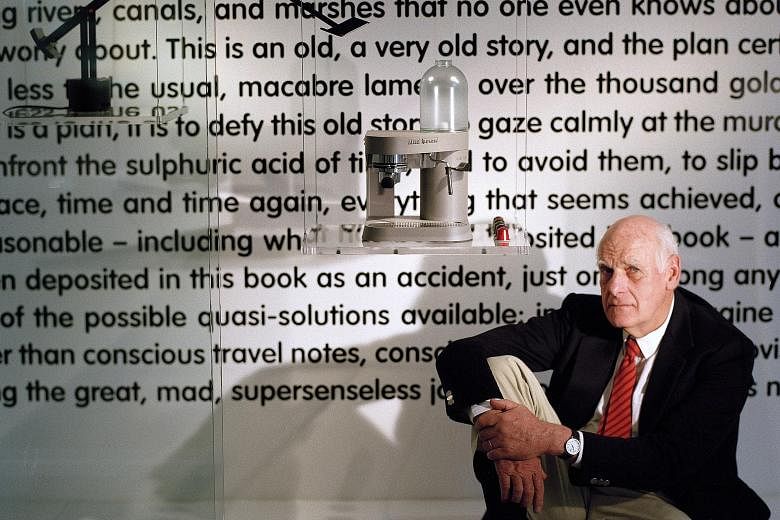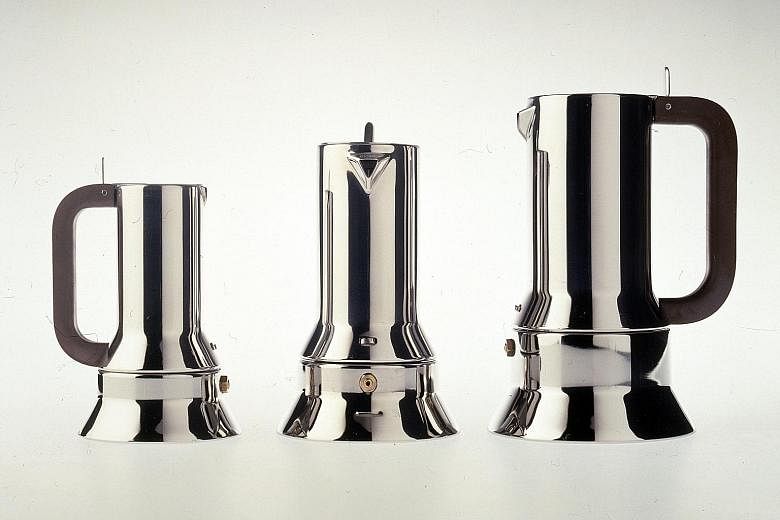NEW YORK • Richard Sapper, an industrial designer whose sleek, precision-engineered prototypes spawned the Alessi espresso maker, the Tizio lamp and the IBM ThinkPad, died on Thursday in Milan. He was 83.
The cause was complications of cancer, his daughter Carola said.
Sapper also designed for Mercedes, Fiat and Pirelli and invented tea kettles that whistled in two keys, emulating an American locomotive. But he was especially revered by coffee connoisseurs for his lustrous stovetop Coban 9090 espresso maker, a graceful stainless-steel, single-piece machine that was introduced in 1979 by Alessi, the Italian housewares manufacturer.
The machine revolutionised home espresso-making, which had been dominated by the Bialetti model, an angular, narrow-waisted cast-aluminum design with a plastic handle. (The Bialetti had been patented by an uncle of Alberto Alessi, now the company's president, in 1933.) The Coban 9090 - named for the town of Coban in central Guatemala, where Sapper's grandfather had harvested coffee - is now in the Museum of Modern Art's design collection.
By 2000, after 1.2 million Coban models had been sold, Alessi introduced an electric version modified to accept packaged pods of ground coffee beans, making it easier to use.
"For frustrated espresso drinkers, the new Alessi machine offers a nearly idiot-proof solution," Eric Asimov wrote in The New York Times.
Sapper influenced not only form, but also function with another design, his linear Tizio desk lamp, which helped introduce the halogen bulb in 1972. Later, his Halley model popularised the lightemitting diode, or LED (even though he personally preferred traditional incandescent bulbs).
That was not the only time he designed a product he preferred not to use. He also ground his own coffee beans the old-fashioned way, instead of using pre-measured pods.
Richard Frank Sapper was born in Munich on May 30, 1932. His father was an Impressionist painter.
In addition to his daughter Carola, he is survived by his wife, another daughter, a son and three grandchildren.
After studying philosophy, anatomy and engineering, Sapper graduated with a degree in business from the University of Munich and began his career in the styling department of the automaker Daimler-Benz (now Daimler AG) in Stuttgart.
He later moved to Milan, where he worked for architect Gio Ponti and in the design division of a department store. He founded his own studio there in 1959.
Researching designs for a teakettle in the early 1980s, he asked a cousin, who restored antique church organs, to come up with an instrument that could replicate the sound of an American locomotive he liked. The cousin produced a double-pitch pipe and Sapper found a manufacturer in Bavaria to make it. The tea kettle was called the Bollitore.
Sapper was credited (with Sam Lucente and John Karidis) with IBM's svelte ThinkPad 701 laptop in 1996 and (with David Hill and Tom Takahashi) the company's X1 Carbon laptop in 2012.
But he lamented that in Apple's infancy, he had passed up an opportunity to do design work for the company's co-founder Steve Jobs because he was busy with other projects in Europe and did not want to move to California.
"Sure, I regret it," he told Dezeen, the architecture and design magazine, in 2013. "The man who then did it makes US$30 million (S$43 million) a year!"
Yet he bemoaned the influence of money on his profession, as industrial designers were becoming less likely to be hired by people who owned their own companies.
"Some of those company owners wanted to make good-looking things because there is pleasure associated with good forms," he told Dezeen. "In many ways, these people were idealists. They didn't make more money because they made a beautiful design. Today, it seems to me that money is the only reason to make design."
He attributed a product's success mostly to "how it's marketed and presented to the public". But he offered some clues as to what constituted a classic.
"It's when the form of an object establishes contact with you and you have to interact with it," he said.
"I am very interested in objects that move and change character. That's the main theme of the Tizio, for example, or even the ThinkPad, which opens and reveals itself like a box of cigars. The Coban also has this nature - it makes noise, steam comes out of it, you see the condensation drops form. It starts to live."
NEW YORK TIMES


